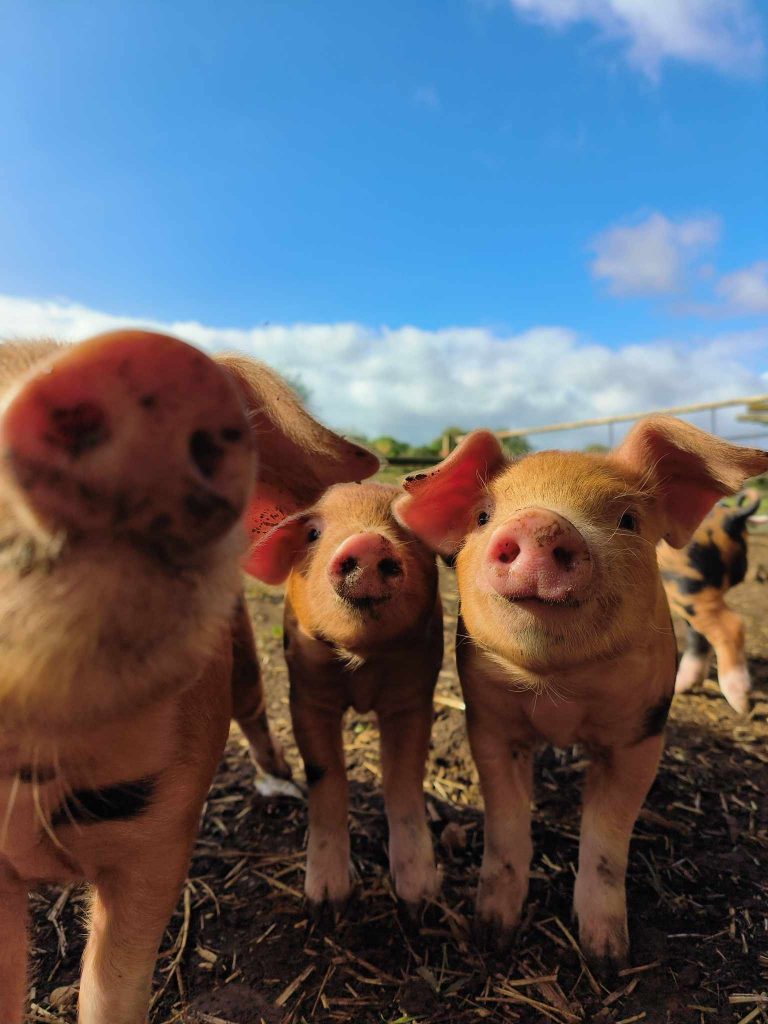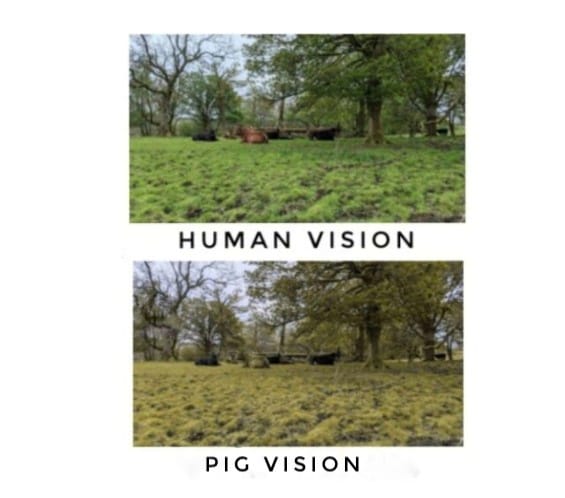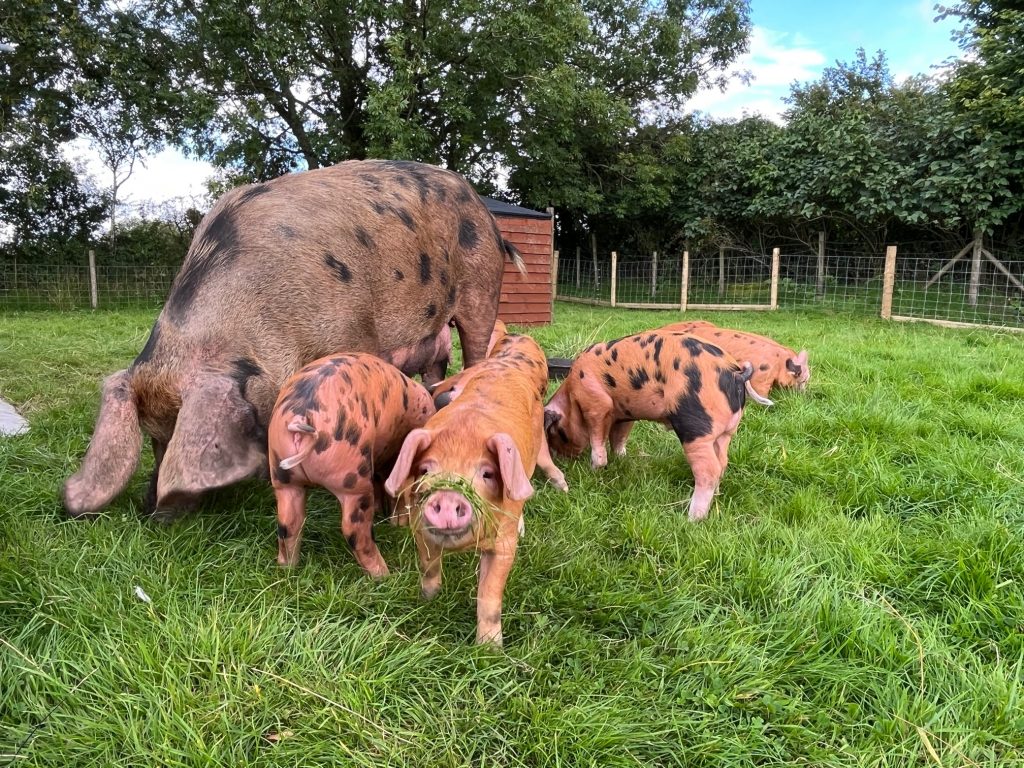
The Pigs Eyesight
The OSBPG Charity is always looking to investigate the wonders of pigs and this topic is by no means any different as we look to the topic of the vision of Pigs.
Pigs possess dichromatic vision, enabling them to perceive the world in blue, green, and various shades of red. However, unlike humans, they are unable to distinguish the millions of colour variations due to the absence of certain large wavelength cones in their vision.
In practical terms, this means that while pigs can identify all variations of blue and green, they lack the ability to distinguish between different shades of red with varying wavelengths.
It’s important to note that it is not only Oxford Sandy and Black Pigs that are not colour blind it is the same with all pigs; they see the world similarly to humans but in solid, distinct colours.
The Colour Vision of Pigs
Pigs can see blue, green, and red colours but are sensitive to different wavelengths as compared to humans. They are dichromatic animals. It means the cones in their eyes are only primarily sensitive to small and medium wavelength colours, i.e., blue and green.
Simultaneously, humans are trichromatic; hence the cones in our eyes can perceive small, medium, and prominent wavelength colours, i.e., blue, green, and red. However, according to a recent study by PigVision Institute, it is unveiled that pigs’ eyes are least sensitive to red colour up to 650 nm.
It demonstrates that there is a slight possibility that pigs can sense a small portion of red colour. You will see the picture below, which show how we and pigs acknowledge different colours.

As justified by the recent studies, pigs’ eyesight can perceive green and blue colours at peak wavelength sensitivity at 439 nm (blue colour) and 556 nm (green colour).
Studies have shown that photoreceptors in a pig’s eye can just about recognise the colour of red, at a reading of under 650 nm. In comparison, humans can see every shade of colour formed under the visible spectrum ranging from 380 nm to 720 nm.
The Way Pigs See the World
Pigs are not colour-blind and can see the world in colour. They are near-sighted and have a wide range of visual fields with a little bit of depth perception. However, their vision is not as clear as ours. It is estimated that the optical power of the pig eye is far much greater than the optical power of humans. Therefore, at far distance their vision will sense a duller outlook.

Also, being dichromatic, the colour perception of the pigs is limited to the blue-green shades. Additionally, their photoreceptors identify the colour red vaguely. You will see from the images on the right, how pigs see the world compared to us.
It is said that pigs see objects as solid colours with dull vision. For example, pigs may see blue sky but cannot identify clouds and rainbows because of being near-sighted.
It has been mentioned before, here on the OSBPG Charity, that to help our pigs with feeling comfortable with their surroundings using solid colours like red, green, and blue for the nearby objects so that pigs can easily distinguish them in the form of water buckets and/or feeding vessels or enrichment toys will be very welcomed.
Apart from the vision, pigs have really good ears and noses. They can sense the world a lot more through sound and smell. Most of the time, they rely on their ears and nose for navigation and surroundings rather than the vision.
Also, their nostrils are sensitive, and through them, they can recognize their owners. Pigs’ vision is indeed poor compared to us, but if we compare their eyesight with say, cattle, they can see a lot better.
Do Pigs Have Night Vision
Pigs cannot see in the dark. Like nocturnal animals, they do not have a thin layer of reflective tissue on the back of their retina called tapetum lucidum. Pigs are diurnal and love to take rest at night. Also, their eyes evolved with more cones than rods that help them differentiate many colours rather than the ability of night vision.
Having fewer rods in their eyes makes it strenuous for pigs to identify the shapes of nearby objects even in the moonlight. Their vision is the same as humans at night. Humans also have very few rods in their eyes; that’s why we are not able to see anything in the dark.
There are two types of photoreceptors in the retina: cones and rods.
Cones are responsible for colour vision, and rods help to sense the light. Both the human and pig eyesight are concentrated towards cones.
Should the need arise to move during the night, pigs will rely on their sense of smell and sound.
The Pigs Eyesight
Pigs have poor eyesight compared to humans, but they have an average vision in contrast to other animals. It primarily depends on which animal we are comparing them to.
Pigs are dichromats, and their eyes have cones that qualify them to distinguish mainly blue-green colours. Also, they are near-sighted; still, they can see up to 300 feet which is far better than an elephant. Not only the sight, but they can also hear from far distances.
In summary, pigs indeed have functional vision, but when it comes to colour perception and clarity, their visual capabilities fall short in comparison to humans.
Pig Vision vs Human Vision
Pig Vision
- Have a dichromatic vision and can see blue and green colours at best.
- Doesn’t have night vision
- Can see up to 90 meters
Human Vision
- Have a dichromatic vision and can see blue, green, and red colours at best
- Doesn’t have night vision
- Can see up to 3 miles

The Oxford Sandy and Black Pig Group is UK’s only pig breed that is a registered charity in England & Wales (1190469) and Scotland (SCO52662). We are creating a better future for our breed, the bloodlines and its breeding potential together with our Independent Pork Producers, Breeders and Keepers. Please consider clicking our donate button so we may continue to look after our breed and our supporters.
Follow us on Facebook and see how we support, help and inspire individuals about our rare breed